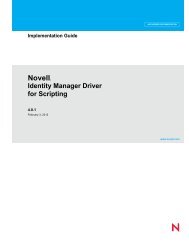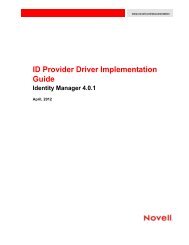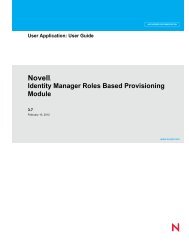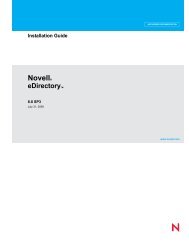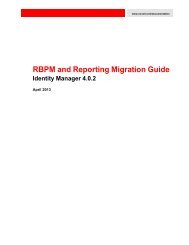Novell eDirectory 8.8 Troubleshooting Guide - NetIQ
Novell eDirectory 8.8 Troubleshooting Guide - NetIQ
Novell eDirectory 8.8 Troubleshooting Guide - NetIQ
Create successful ePaper yourself
Turn your PDF publications into a flip-book with our unique Google optimized e-Paper software.
7Obituaries<br />
There has been a great deal of confusion surrounding obituaries stored in the directory and, as a<br />
result, some people have developed poor business practices to deal with then. Unlike some directory<br />
products, <strong>Novell</strong> <strong>eDirectory</strong> ensures referential integrity between objects. For example, if Group A<br />
has a member, User B, and User B is deleted, the directory automatically removes the reference to<br />
User B from Group A. Obituaries exist as operational attributes placed on objects by <strong>eDirectory</strong> as<br />
another way of ensuring referential integrity during delete, move, rename, restore, and other<br />
operations.<br />
There are three general classifications for obituaries:<br />
• Primary obituaries include the types Dead (0001), Restored (0000), Moved (0002), New RDN<br />
(0005), and Tree New RDN (0008).<br />
• Secondary obituaries are generally associated with a Primary obituary and represent the agents<br />
and partitions that need to be notified of the operation specified in the Primary obituary. They<br />
include the types Back Link (0006), Used By (000C), and Move Tree (000a).<br />
• Tracking obituaries include the types Inhibit Move (0003), Old RDN (0004), and Tree Old<br />
RDN (0007).<br />
Obituaries, with the exception of Tracking obituaries, must move through a set of synchronizing<br />
states:<br />
• Initial State or Issued (0)<br />
• Notified (1)<br />
• OK to Purge (2)<br />
• Purgeable (4)<br />
The states are recorded in the Flags field in the obituary attribute. Before an obituary can move to<br />
the next state, the current state must have been synchronized to all replicas of the real object. In<br />
order to determine whether all replicas in the ring have seen a given obituary state, a vector is<br />
computed from the transitive vector. In <strong>eDirectory</strong> 8.6 and later, a nonstored Obituary Vector is used.<br />
In previous versions of <strong>eDirectory</strong>, the Purge Vector is used. If the Modification Timestamp (MTS)<br />
on the obituary is older than the corrupted vector, the server responsible for that obituary can<br />
advance it to the next state.<br />
For a Secondary obituary of type Back Link, the agent that holds the master replica of the object<br />
with the obituary is responsible for advancing the states. For a Secondary obituary of type Used By,<br />
the replica agent that created it is responsible for advancing the obituary states as long as that replica<br />
still exists. If it does not still exist, the agent holding the master of that partition takes over<br />
advancing the obituary states for the Used By obituary. For a Move Tree obituary, the master of the<br />
root partition is responsible for advancing the states.<br />
Primary obituaries can be advanced in their states only after all Secondary obituaries have advanced<br />
through all of their states. After the Primary obituary reaches its last state, and that state<br />
synchronizes to all servers in the ring, all that remains is the object husk, which is an object without<br />
attributes—one which can subsequently be purged from the system by the Purge Process. Tracking<br />
obituaries are removed after the Primary obituary is ready to be removed or, in the case of<br />
7<br />
novdocx (en) 6 April 2007<br />
Obituaries<br />
47




